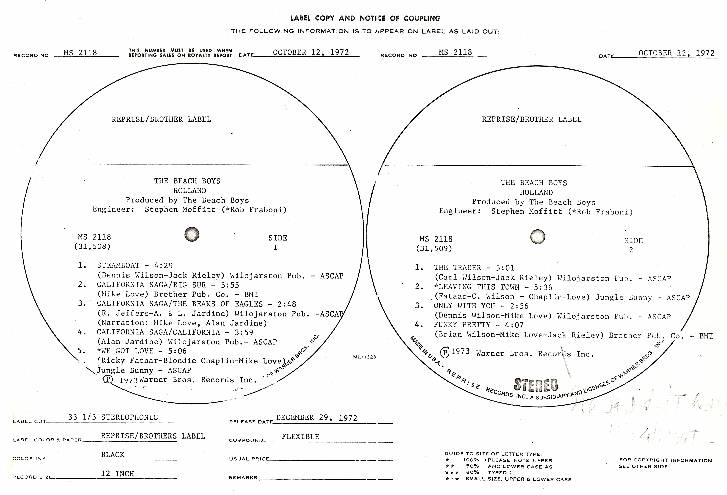

This shows an internal record company document explaining to
the printers how the labels of Holland should be laid out.
A document like this is called a Label Copy and Notice of Coupling!
Note that side one ends with We Got Love.
Thanks to the kind generosity of renowned Beach Boys collector Steve Mayo for
these scans.
The Holland album was released as an LP in various
configurations, as an 8-Track, as a Cassette, a Reel-tape, a CD etc.
Many feature wildy varying song sequences. Check it out at the bottom of this
page!
This is a detail photo of the rear sleeve of a very early UK Test Pressing of the Holland album. Note that the song We Got Love is included with the composer credits. Also please note the publication date of 1972, making this the earliest known copy of Holland so far discovered.
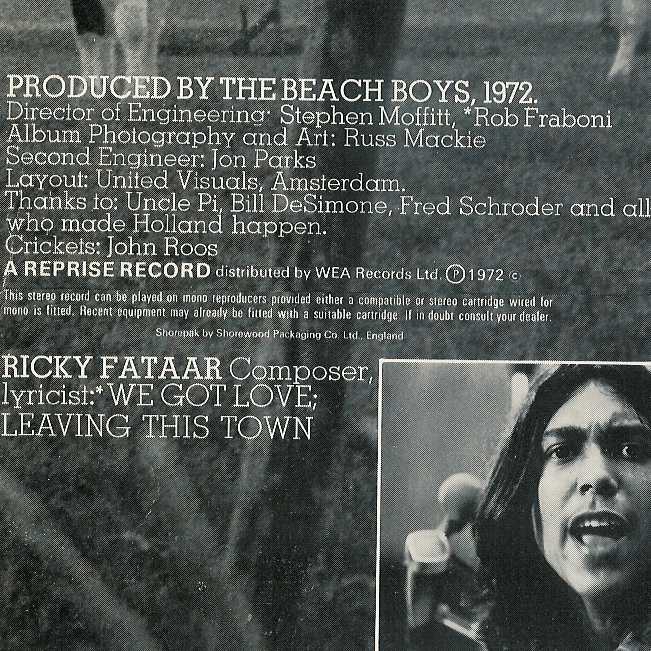
here is a poster to promote the Holland album
many thanks to my friend Jim Kosek for giving me this fine poster!
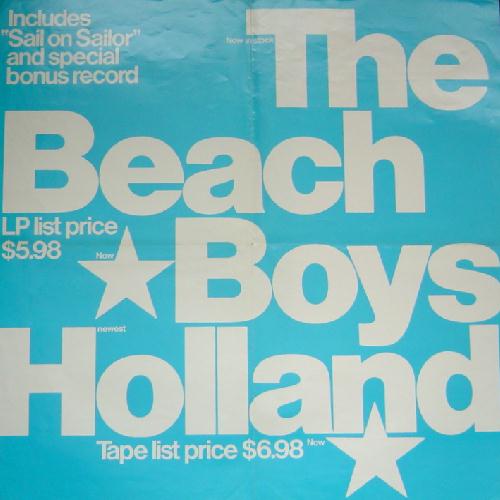
And here is the Warner Bros reel-to-reel tape of the 60 second
Holland Radio Spots.
I will consider any offer to sell such a tape to me. (scan with thanks from
"Bgaswoodie")
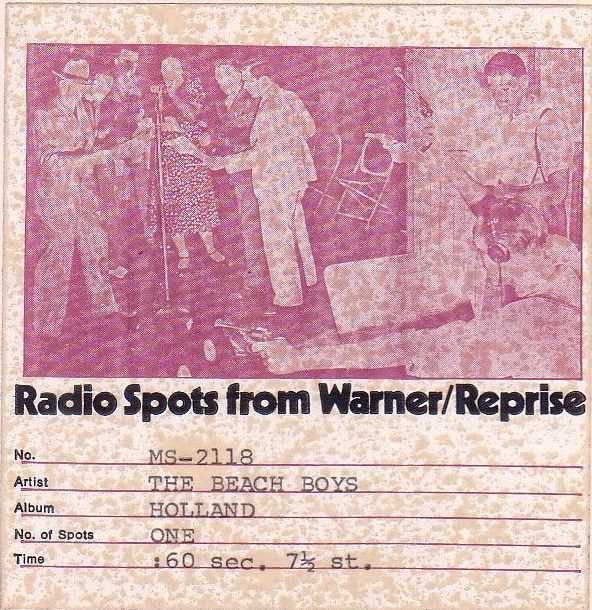
here is a picture of the Beach Boys in Baambrugge, Holland
thanks to Gabriel Witteveen
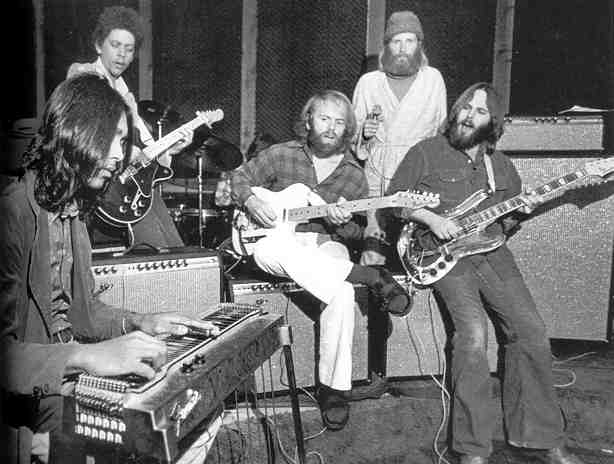
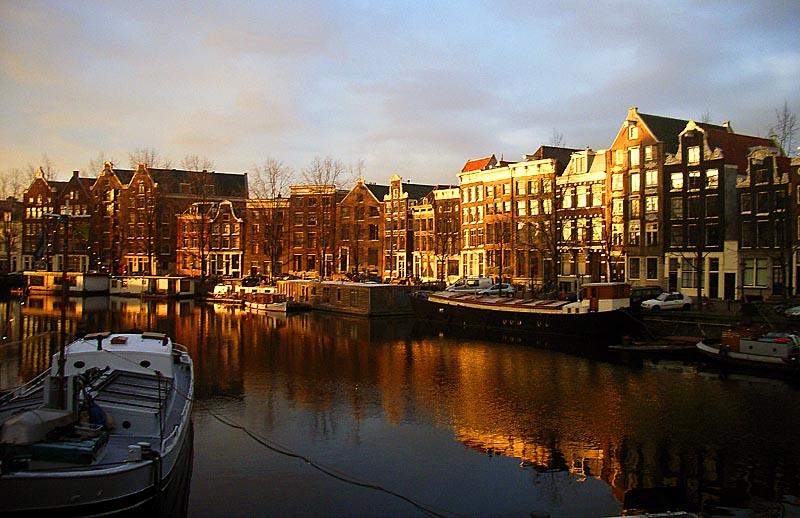
This is the canal in Amsterdam where the Holland sleeve photo was made. Its called the Kromme Waal.
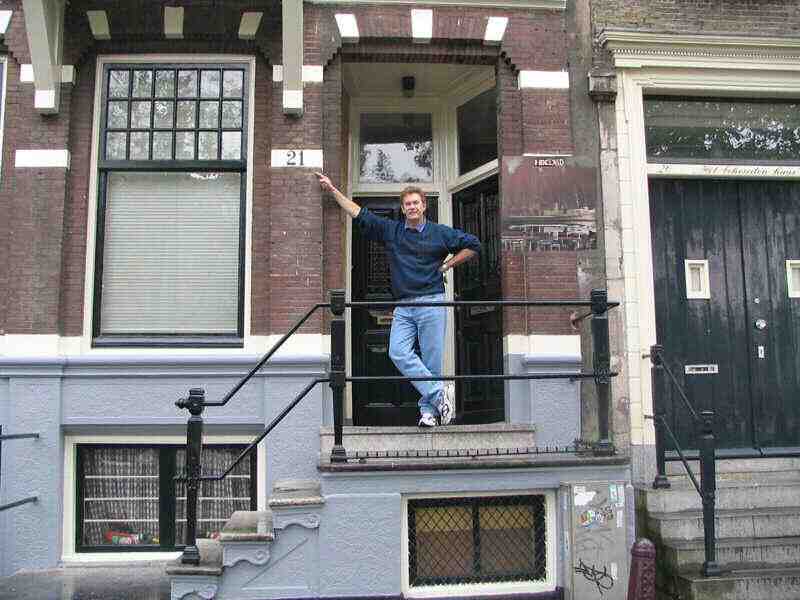
Here is my good friend and fellow collector Tertius Louw photographed where the Holland sleeve photo was taken, in Amsterdam.
Introduction
When the Beach Boys departed from the Netherlands in August 1972, they took back with them most of the master tapes of their new masterpiece Holland. They continued working on the album in Los Angeles (at Village Recorders) and delivered the tapes to Warner Brothers, who promptly turned the album down for lack of a hit single. So a new song Sail On Sailor was hurriedly recorded in California and added to the start of Side A. Sadly the original studio recording of We Got Love, an anti-apartheid song written, sung and played by Blondie Chaplin and Ricky Fataar, was removed from the album.
Germany
The German record company WEA already had tapes to produce the album in its original form and then received instructions to correct the album. But they made a mistake. The first batch of records to hit the German shops in 1973 featured the original running order on Side A as conceived by the Beach Boys. Later the error was discovered and corrected pressings were made. How can such a mistake be made?
Mistake
If you look very closely at the matrix numbers for Side A and Side B on the two versions of the disc, a very plausible scenario seems to suggest itself. Since the abbreviation "RE" stands for Remastering, then it seems that WEA accidentally remastered Side B instead of Side A! They corrected the wrong side. As a result they produced one of the most prized items for collectors of the Beach Boys and the Flames.
The details
The German catalog number of the record was REP 54008 (MS2118). The record labels themselves are exactly identical and do not mention "We Got Love" so determining if you have found a "We Got Love" pressing requires you to study the grooves. The spacing of the songs on side one will reveal all! It's easy, so please have a look below. The pressing on the right, featuring the corrected song line-up was donated to the Flames collection by my kind friend Jim Kosek. Thanks Jim!
| First German pressing with "We Got Love" | First corrected German pressing with Sail On Sailor |
| Side A Matrix: WEA 31508-1 II | Side A Matrix: WEA 31508 RE 1 - MS2118 1B |
| Side B Matrix: WEA 31509 RE 1 - MS2118 1A | Side B Matrix: WEA 31509 RE 1 - MS2118 1A |
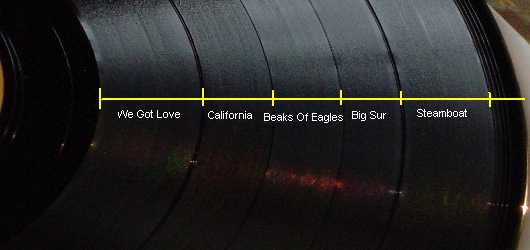 |
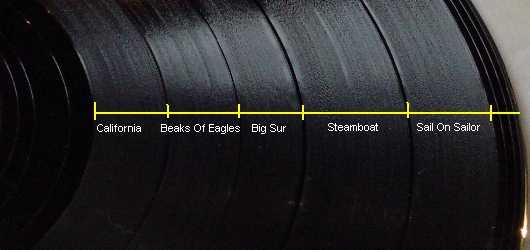 |
| Original Side A running order 20:19 | Later corrected Side A running order 18:26 |
| 1. Steamboat 4:29 2. California Saga: Big Sur 3:55 3. California Saga: The Beaks Of Eagles 2:48 4. California Saga: California 3:59 5. We Got Love 5:08 |
1. Sail On Sailor 3:15 2. Steamboat 4:29 3. California Saga: Big Sur 3:55 4. California Saga: The Beaks Of Eagles 2:48 5. California Saga: California 3:59 |
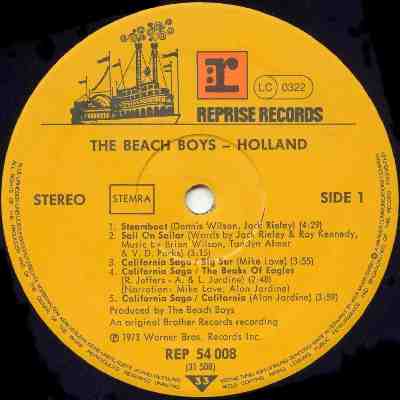 |
Gabriel Witteveen, an active
Beach Boys collector in the Netherlands recently spotted this very
interesting variation of the label of the Holland album.
Notes: 1. The label suggests that Steamboat opens the album although the actual disc has the corrected standard track sequence we all know, starting with Sail On Sailor, then Steamboat and so on. 2. This disc is made in Germany. There are at least two variations, one with Stemra (shown) which is the Dutch Music rights organisation and one with Gema (not shown) which is the German counterpart. 3. The LC0322 code suggests that this is a more recent pressing. Both the German variation with Gema and the Dutch variation with Stemra are in the Flames collection, thanks to the kind generosity of noted Dutch collector and rock journalist Gabriel Witteveen. |
Lyric sheet
The album came with a lyric sheet. Many examples of this sheet are in the Flames Collection and all of them feature two remarkable oddities. There is a huge whole in the lyrics at the end of Side A and the lyrics of Sail On Sailor are nowhere to be seen. This suggests that the lyrics of We Got Love were included originally and removed just before printing. Here is the relevant portion of the lyric sheet, showing the "We Got Love hole". (More recently a USA pressing was added to the Flames collection, with a lyric sheet featuring Sail On Sailor, albeit in a slightly different font)

The lyrics to "We Got Love"
published by Jungle Bunny / ASCAP
written by Ricky Fataar, Blondie Chaplin and Mike Love
Are you taken by surprise
When your fellow man decides
That what you�re doing isn�t right
Do you listen, know you�re right
Well, you can keep on telling lies
That keep you deaf from people�s cries
Well there�s something you should see
We got love to keep us free
We got love, we got love
We got love and we gonna change our world, that�s right
We got love, we got love
We got love and we gonna change our world, that�s right
I made my home out in the city
Just to see what I could find
And though my heart was in my country
I was not there to close my eyes
Said, I�ve been tired of all the same
Must�ve been a Siren in my head
I�ve been writing all my feelings
All this running and my temperature won�t change
They say you reap just what you sow
The wise men all have told us so
Trust those feelings deep within
How you must treat your fellow man
Evolution isn�t strange
Nature itself demands the change
The universe is on our side
We can�t hold back the coming tide
We got love, we got love
We got love and we gonna change our world, that�s right
We got love, we got love
We got love and we gonna change our world, that�s right
I made my home out in the city
Just to see what I could find
And though my heart was in my country
I was not there to close my eyes
Said, I�ve been tired of all the same
Must�ve been a Siren in my head
I�ve been writing all my feelings
All this running and my temperature won�t change
We got love, we got love
We got love and we gonna change our world, that�s right
We got love, we got love
We got love and we gonna change our world, that�s right
We got love, we got love
We got love and we gonna change our world, that�s right
We got love, we got love
We got love and we gonna change our world, that�s right
The vocals
On the original studio recording, it seems virtually certain that the singing is shared by Ricky Fataar and Blondie Chaplin. Ricky sings the verses and the first two lines of the chorus. Blondie takes over at the start of the line "And though my heart was in my country".
Live version
As many visitors to this web site know well, the song is of course widely available as a live recording on the Beach Boys In Concert album which was also released in 1973. The lyrics and running order of that version is almost identical to the original studio version, but with a guitar solo at the end, and a proper ending instead of a fade-out. Possibly the song was included on the live album to compensate Ricky Fataar and Blondie Chaplin for it being scrapped off Holland.
Canada
The first series of records pressed in Canada (Brother/Reprise MS 2118) featured a different error. The Canadian discs feature the corrected running order but the song We Got Love is still mentioned on the sleeve. The lyric sheet has the full lyrics of Sail On Sailor printed in the space left over after the deletion of We Got Love. The bonus EP has a stiffer cardboard sleeve than other countries.
France
The earliest French releases of Holland (Brother/Reprise 54008) also mentioned We Got Love on the Sleeve. Thanks to Brad Elliott for pointing this out. It is interesting to note that Mike Love is not credited on the sleeve for his lyrical contribution to 'We Got Love'. Here is a portion of the rear of the French sleeve.
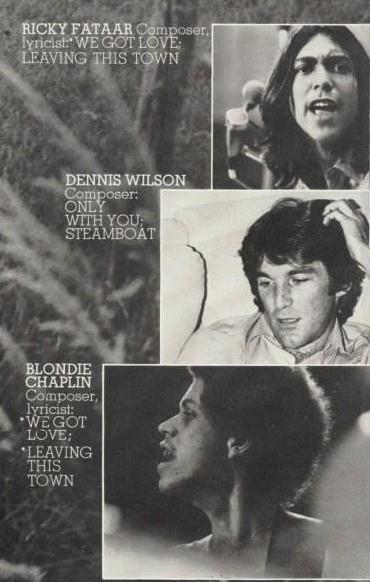
Chronology
Brad Elliott very kindly sent us the following chronology to further clarify the release of Holland:
Oct. 9, 1972 -- Side 1 of HOLLAND (with "We Got Love") sequenced
and compiled.
Oct. 10, 1972 -- Master tapes for HOLLAND submitted to Warner Bros. A release
date of Nov. 5, 1972 initially was set. [This information from Warner Bros.
files].
Oct. 12, 1972 -- "Label copy" information prepared by Warner Bros. for
HOLLAND. Planned release date changed to Dec. 29. Interestingly, the original
"label copy" did NOT include the "Fairy Tale" EP! [This
information from the "label copy" attached to test pressings of the
album.]
Nov. 28-30, 1972 -- "Sail On Sailor" recorded.
Dec. 4, 1972 -- Side 1 of HOLLAND remastered to include "Sail On
Sailor."
Jan. 8, 1973 -- HOLLAND released in the U.S.
Credits
We are very grateful for the enthusiasm and help from many friends in providing information leading to this great find. We would especially like to credit Klaas Jelle Veenstra, a highly motivated Beach Boys collector living in the north of Holland, and Brad Elliott, author of Surf's Up, the best reference book about Beach Boys recordings.
The very first Dutch pressing of Holland has been added to the Flames collection in the first few days of 2005. This comes with a glossy band photo and a tyrped press release. Here is the photo.
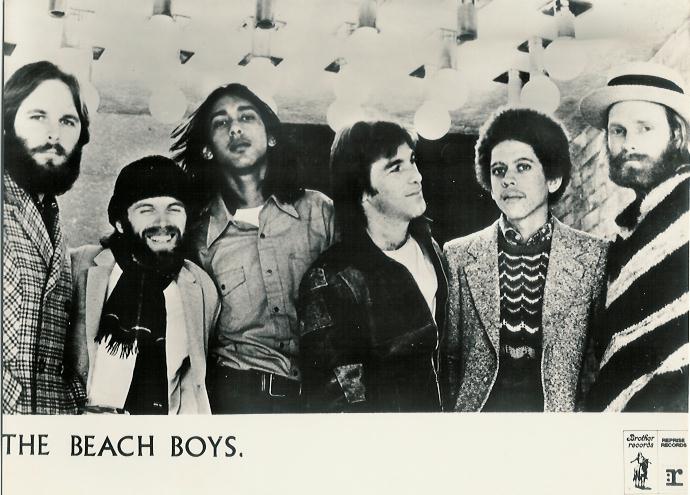
Now all you serious Beach Boys collectors, go find your copy of the USA double album So Tough / Pet Sounds on Brother Records and look at the inside of the gatefold sleeve. The photo above is not the same but obviously taken a few seconds before or after. Also note that the photo above does not include Brian Wilson suggesting that he was added to the album sleeve picture artificially!
Here is the press-release, presented on official note paper of B.V. NEGRAM, the record company then responsible for distribution of Warner Brothers, Reprise, Elektra and Atlantic records.
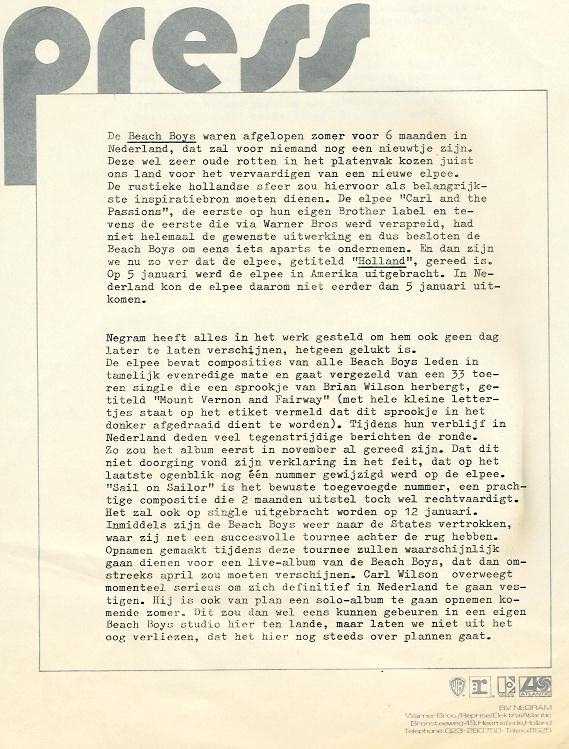
The press release was written by Sjeng Stokkink. There is an interesting "N.B" at the end of page 2 of the press release: The single "Mount Vernon" will not appear in the shops in the pressing you have received here. We apologise for the pops and crackles on your copy. Waiting for a re-press would reduce the impact of a timely release for the package that you have just received.
Sadly the technically imperfect pressing of the "Mount Vernon" EP was not included with this copy so we cannot report just how bad it was. Other copies of the Holland album from the Netherlands, have reasonable sounding copies of the EP.
by Bas M�llenkramer
Holland is an album that has not only withstood the test of time but has grown in stature through the years. At the time of writing this (early spring 2003) we have just quietly passed the thirtieth anniversary of its release. It should have been released late 1972 but only came out in early 1973. Holland was of course recorded mainly in the Netherlands during the summer of 1972. In fact Leaving This Town, We Got Love and Sail On Sailor were recorded in California after the group returned there. After all this time it seems that lovers of rock music in general and of the Beach Boys in particular show a growing fondness for what seems increasingly like becoming a timeless classic. In a cheap-and-cheerful Dutch record collecting magazine called Platenblad, a recent poll revealed that Holland came in a close second after Pet Sounds as the readers all-time favourite Beach Boys album. And aside from anything else the record shows that the Beach Boys were capable of producing awesome music in the absense of their supposed leader Brian Wilson.
How you hear the record depends on your preference. If the Beach Boys had been given their choice, the album would not have included Sail On Sailor which was a last-minute commercial record-company addition to give the album a hit single. As explained above, Holland was originally to have included a second Chaplin-Fataar composition entitled We Got Love.
Starting an album off with a bang is a commonly used way to create a lasting impression. The Beatles white album (Back In The USSR) and Led Zeppelin IV (Black Dog) are supreme examples of how to succeed with this simple trick. But starting an album off with a slow dramatic piece is a more challenging means of constructing a rock album. Electric Ladyland starts off with the magnificent slowly grooving title song. Dark Side Of The Moon begins with Breathe In The Air. The reader will easily manage to think of examples of both.
The original Beach Boys-conceived Holland would have begun with Steamboat. This is a very slow song written by Dennis Wilson. When you listen to the complete Holland album in it's original sequence, it actually becomes a different record to the one most of us know. Although it may sound sacriligious now, the reader is urged to temporarily forget Sail On Sailor as the opening tune, and think of the album starting out with a slow fade in to Steamboat with it's weird slow rhythm and nautical sound effects.
Steamboat sets a completely different opening mood to the album which lasts through the rest of the music. In effect, with its original sequencing Holland becomes a different record. A more pastoral relaxed mood is set. When Steamboat follows Sail On Sailor, as on the well known released version, the song seems to feel like a let-down after an energetic start. But Steamboat becomes a magnificent slow album openener when it is restored to its rightful place at the start of side one. The recent 24-bit CD remaster does the song full justice and thankfully the remastering engineers have allowed the slight tape hiss to remain so we can hear the song in all its glory. It's one of those tunes you simply cannot play loud enough. The reader is strongly urged to listen to Steamboat as loudly and with as much treble as possible without hearing Sail On Sailor first. The slide guitar solo is devastatingly beautiful and in fact the slide plays a role in much of the song, for example the delicately held quivering notes in the breaks preceding each new verse. The engineering on the song is a statement in itself. It takes nerve to record like this, with the crashing treble of the cymbals held back in favour of the delicate vocal balance of the harmony singing.
Steamboat is followed by the California Saga, a trilogy of songs centred around compositions by Al Jardine and Mike Love. It the original sequence the Saga sits in the middle of side one of Holland. Those readers wishing to track down a rare early German copy of Holland, mistakenly featuring side one in its original sequence, can identify the disc visually by the way the Saga occupied the middle of side one. When the Saga is preceded by Steamboat only, it gains in energy and power. The bouncing California which closes the Saga becomes the first up-tempo moment on Holland.
The Saga is followed by We Got Love. It is written by Blondie Chaplin and Ricky Fataar, together with Mike Love. It is not known how extensive the lyrical support of Mike Love was in writing this anti-apartheid anthem. An early French mis-printed album sleeve (see above) mentions the song, but fails to credit Mike Love's contribution. This might be taken as indicating that his contribution was minimal, but this has not been verified. We Got Love is a powerful song, which later appeared in a live version on the In Concert double album.
Sadly the recording quality of the studio version of We Got Love is below the standard set by the rest of the Holland album. Even when auditioned from an original mint-condition German pressing, on a good quality stereo system, it somehow fails to deliver the energy that is promised. While most of Holland has a breathtakingly wide stereo panorama, with a wide open almost scenic stereo mix, We Got Love presents the listener with a closed narrow constricted sound. The piano accompaniment is strangled and brittle and there is very little treble to add any sparkle to the song. The bass is just a little too muddy, further clouding the sound. We might dream of a remix being made for a future Holland-Sessions CD release. The playing and singing, is however, excellent. The song is performed with gusto. The band consists of piano, organ, guitar and drums and of course the fabulous vocals for which the Beach Boys have become legendary. Lead singing is shared by Ricky Fataar and Blondie Chaplin.
Side two of Holland kicks of with Carl Wilson's (then) small son Justin saying Hi to all us listeners. Then comes Carl Wilson's breathtaking masterpiece The Trader. In every sense this song challenges the senses. It is remarkable for its subject matter (white settlers' behaviour in early Northern America), its lyrics, its melody line, its musical arrangements and the ethereal and unmatched vocal accompaniment. The Trader is one of those songs you never want to end, and when the five minutes are up you want it to continue, matching the closing lyrics. The Trader is a transcendent song, with the whole becoming much more that the sum of its parts. Ricky Fataar's drumming is flawlessly tasteful and his jazzy swinging brush work in the second half is nothing short of perfect. The bass is played by a synthesizer and the reader is once again advised to get a big big stereo and crank this tune up loud to get the full power of the bass synth when it hits the deep lows.
Leaving This Town is a dramatic Ricky Fataar/ Blondie Chaplin tune with gorgeous singing by Blondie. What makes this song really special is its extraordinary unhurried synthesizer solo. It leads to a wonderful dramatic break at its end. It is an excellent example of the kind of feeling that can be achieved when accomplished musicians switch instruments. Ricky Fataar is mainly a drummer but plays many instruments besides. Here he tackles the synthesizer with a fine result.
Only With You is a Dennis Wilson song, helped by Mike Love. It's a wonderfully delicate ballad, superbly underplayed and assisted by strings. This song is in fact so delicate that its difficult to find vinyl pressings that play this song cleanly. The latest 24-bit remastered CD does it fair justice.
The final song on Holland is Funky Pretty. On the version of Holland with it's original running order, this is the only tune in which Brian Wilson gets any writing credits at all. It's also the most musically complex song, featuring a very deep tapestry of intertwined instrumental and vocal lines. The complexity can sometimes baffle the listener, and it is this reviewer's opinion that it may have benefited from another take at a different speed or with a different setting of instruments. Funky Pretty is also very special for a little known bit of audio trickery. A synthesizer with an extremely high pitch is used in the second half of the tune to provide what sound vaguely like bird noises, or perhaps bat noises. This sound is all in the uppermost octave of human hearing, namely the range between 10 000 and 20 000 Hertz (10 kHz - 20 kHz). On vinyl copies they are hard to hear properly, partly because needles don't like moving around 15 thousand times a second! The latest CD makes it easier to hear. For your delight and education I have used computer software to extract these noises from the rest of the music. The frequency was then dropped making it far easier to hear that it was actually a musical performance on an electronic synthesizer.
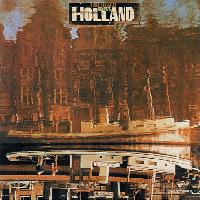
|
Japan CD Brother / Toshiba Note: second Toshiba release in paper mini LP sleeve
|
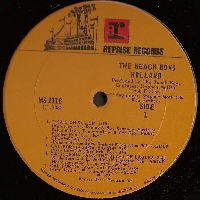
|
USA (probably for export) Reprise MS 2118 Nearly all USA pressings are on the yellow Brother/Reprise label. This rare USA pressing is on the brown Reprise label, although the accompanying EP is on Brother/Reprise. It is not known why this pressing was made, however a strong possibility is export to territories where the Brother label was not registered. This also happened with UK Beatles albums on Apple, which were pressed on Parlophone for export to territories where the Apple label was not registered. |
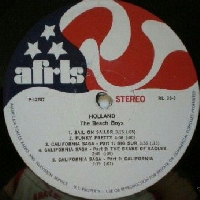
|
Armed Forces LP AFRTS label Note: half of Holland on one side of an LP with songs by Charles Aznavour on the B-side. This was intended for American Forces radio stations. |

|
Japan CD Sony Note: includes lyric sheet, with printed lyrics of the EP, and OBI Note: superb reissue in the Nice Price Line |
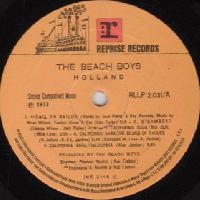
|
Brazil LP (no EP) Reprise Note: the sleeve is made of paper surrounded by plastic, a common practice in Brazil. The California Saga is cut as a single track on this record. Perhaps this is how it should be! Note: many thanks to my friend Chris Woods for generously adding this wonderful record to the Flames collection. |
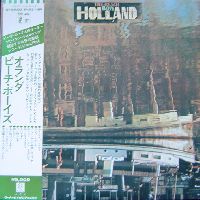
|
Japan Early pressing (no EP) Brother Note: includes lyric sheet, with printed lyrics of the EP, and OBI |

|
Japan CD Capitol / Toshiba Note: first Toshiba release |
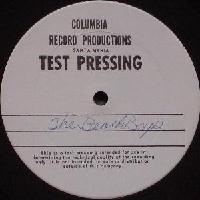
|
USA Test Pressing Columbia Note: this is the test pressing of the second edition of Holland without We Got Love
|
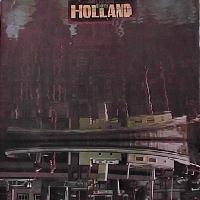
|
New Zealand LP Reprise RS 2118 Note: Released on the brown Reprise label. Includes EP in picture sleeve and lyric sheet |
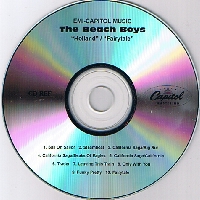
|
USA CDRTest Pressing Capitol Note: includes EP
|
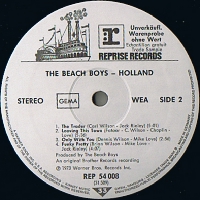
|
German white-label trade sample Reprise 54008 We Got Love is not included |
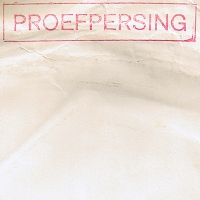 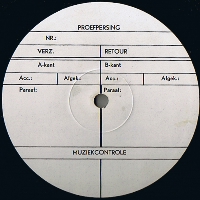
|
Netherlands White Label Test Pressing (two
versions, We Got Love and Sail On Sailor) Brother REP 54008 The Flames collection has two different versions of this Dutch test pressing. The first version has the original LP running order, starting off with "Steamboat" and also featuring the lost song "We Got Love". "Sail On Sailor" is missing from this version. The second version has the later running order, with "Sail On Sailor" as opener. The upper picture is of the original inner sleeve.
There is no outer sleeve. Note: special thanks to Franck Leenheer of Leiden, the Netherlands for supplying the "We Got Love" version of this test pressing. |
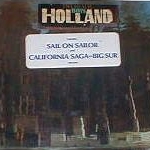
|
USA Brother MS 2118 Early pressing still in shrink wrap, complete with EP, lyric sheet and sticker on the front. A version with a brown sticker is also in the collection. |

|
Zoo World The Music Megapaper April 1973 Note: contains very favourable review of Holland |
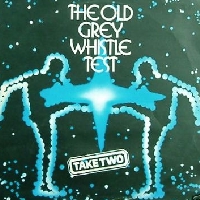
|
Old Grey Whistle Test Take Two BBC Double album 1976 Note: features Sail On Sailor (studio recording) |
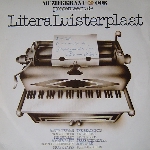
|
LiteraLuisterplaat Warner Brothers 1976 Note: this LP was released in the Netherlands by Warner Brothers in 1976 to accompany the music magazine Muziekkrant Oor. Side two of the album opens with The Trader from the Holland album. The record also features Frank Zappa, Randy Newman, Van Morrison, Todd Rundgren and many other contemporaries. Bonnie Raitt is here too, and Ricky Fataar would become her permanent drummer decades later. |
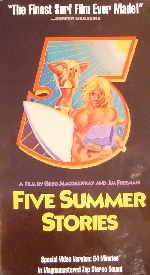
|
Five Summer Stories Pacific Ocean Highway Video 1972-1994 Note: surf movie featuring music from Holland and other Beach Boys albums. Generously donated to the Flames collection by Lee Dempsey. Thank you! |
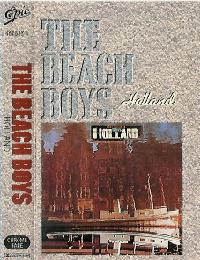
|
NL Musicassette Epic 467837-4 |
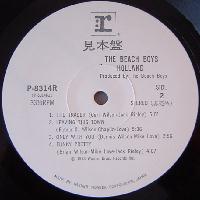
|
Japan Promo (no Mt. Vernon EP) Reprise white label |
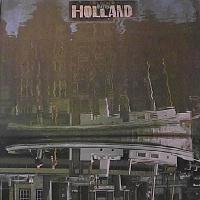
|
UK 1972 Test Pressing (complete We Got Love
version) Reprise/Brother K54008 white label, no printing Note: this UK Test Pressing of Holland is dated 1972 on the rear of the sleeve! The elusive song We Got Love is mentioned on the rear sleeve and also featured on the record. Sail On Sailor is nowhere. The EP and the Lyric sheet did not accompany this early test pressing. Note: matrix numbers (it seems matrices were
shipped from the USA to the UK and then had the K54008 numbers added)
|
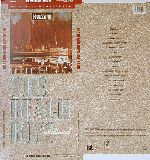
|
USA Holland Longbox (not yet folded) Epic/Caribou ZK 46952 Note: this is an unfolded carton intended to make the long-box for the first Holland CD release on the Epic/Caribou label. Note: a complete sealed long-box CD is also in the Flames collection |
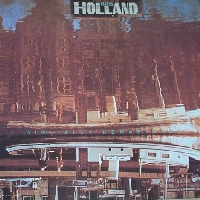 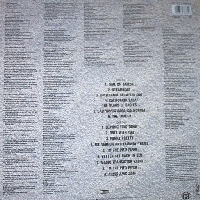 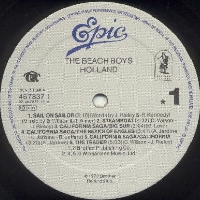 |
Reissue (Netherlands) Epic Caribou Note: this late vinyl LP reissue of Holland features all the songs including the entire EP all pressed on one single 12 inch vinyl disc. The Trader is the last tune on side one. Note: a Spanish pressing of this reissue is also in the Flames collection. It has a sticker reading "Precio Redondo" meaning reduced price. |
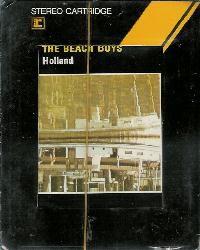
|
UK 8-Track Cartridge (still sealed) Reprise K854008 Note: The song sequence is different from the LP. Program 1: Sail On Sailor, Leaving This Town, Only
With You
|
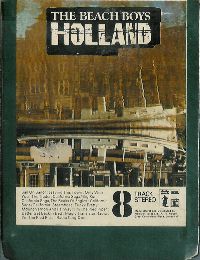
|
UK 8-Track Cartridge (still sealed) Reprise Y8K8 54008 Note: The song sequence is different from the LP. Program 1: Sail On Sailor, Leaving This Town, Only
With You
|
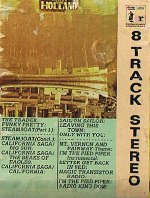
|
Canada 8-Track Cartridge Reprise 8RM-2118 Note: The song sequence is different from the LP. Program 1: The Trader, Funky Pretty, Steamboat
(beg): Total time 12:12
|
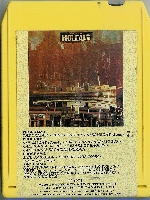
|
Canada 8-Track Cartridge Reprise 8RM-2118 Note: The song sequence is different from the LP. Program 1: The Trader, Funky Pretty, Steamboat
(beg): Total time 12:12
|
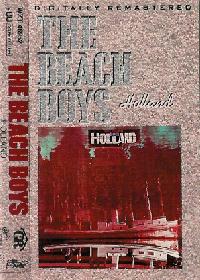
|
Canada Musicassette Epic Caribou WZT 46952 Note: So far this is the only cassette version of
the Holland album featuring the songs in the correct running order. Side
one of this tape has a lengthy pause at the end, due to a far longer side
two. Note: a US version of this cassette with slightly different catalogue number is also in the Flames collection |
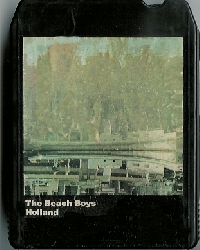 |
USA 8-Track Cartridge Brother REP M8-2118 Note: The songs sequence is different from the LP. Steamboat had to be cut in two to create four equal length programs. Program 1: The Trader, Funky Pretty, Steamboat
(beg): Total time 12:12 |
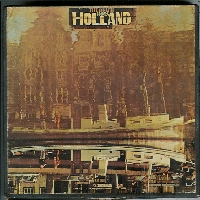 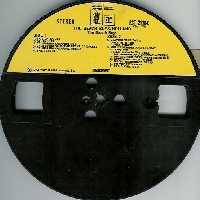
|
USA Reel-to-Reel tape 7-1/2 i.p.s. Brother RST 2118-C Note: The songs sequence is the same as the LP, with The Trader being included on side one. The fairy tale is included at the end of side two. The sound quality is excellent on my classic Akai GX-4400D. |
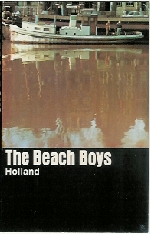
|
USA Musicassette (Upside Down version) Brother REP M5 2118 Note: completely different song order Note: Only known Holland with upside down sleeve photo Side One: 1. Sail On Sailor 2. Steamboat 3. Complete California Saga 4. Only With You 5. Funky Pretty Side Two: 1. The Trader 2. Leaving This Town 3. Complete EP |
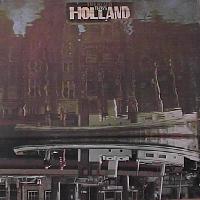
|
Australia Brother MS 2118
|

|
USA Brother MS 2118 This is probably a second printing or an early reissue. The lyric sheet insert includes the lyrics to Sail On Sailor!! |
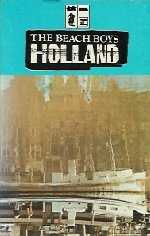 |
UK Musicassette Brother K 454008 and ZCK4 54008 Note: completely different song order Note: two different versions of this cassette are in the Flames collection Side One: 1. Sail On Sailor 2. Leaving This Town 3. Only WIth You 4. Complete EP Side Two: 1. The Trader 2. Steamboat 3. Funky Pretty 4. Complete California Saga
|
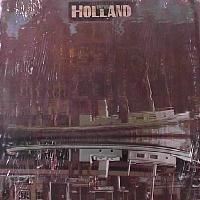 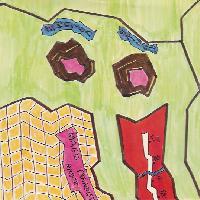 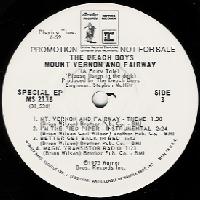 |
USA Promo (2 different copies) Brother MS 2118 still in shrink wrap white label with black rim on LP and white label on EP EP in picture sleeve, and white inner sleeve lyric sheet insert without lyrics to Sail On Sailor Without a doubt this mint promo is the best sounding version of Holland in the Flames collection. Recently another promo copy was added to the Flames collection by Brad Elliott. This version has a lyric sheet including Sail On Sailor! |
 |
German mispressing Reprise 54008 side one has We Got Love Sail On Sailor is not on the album brown Reprise label both sleeve and label mention Sail On Sailor but there is no mention of We Got Love This is the most valuable version of Holland in the Flames collection. |
 |
German corrected pressing Reprise 54008 correction of mispressing above brown Reprise label It is very difficult to tell this record apart from
the mispressing above. Study the label differences as shown above, and
look at the lengths of the songs. |
 |
German late re-pressing Reprise 54008 side one label error brown Reprise label The label suggest that Steamboat comes before Sail On Sailor, which is not the case. Two versions are in the Flames collection, for the
Dutch and German markets.
|
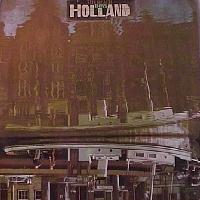 |
French mispressing Reprise 54008 We Got Love is mentioned on the sleeve yellow Brother label Easy to spot because the sleeve has an orange glow. Laminated cardboard tends to curl out. |

|
Canadian mispressing Brother MS 2118 We Got Love is mentioned on the sleeve yellow Brother label |
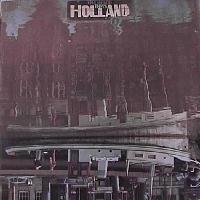 |
French corrected pressing Reprise 54008 We Got Love is deleted from the sleeve yellow Brother label The sleeve of this is a standard Euro sleeve without a country designation.
|
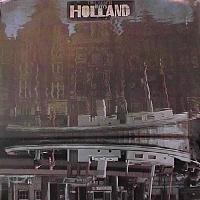 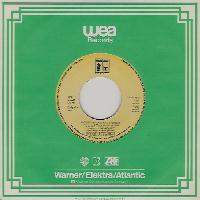 |
Netherlands Brother 54008 yellow Brother label a copy with blue round sticker on front sleeve is also in the Flames collection Note 1: Standard release with EP Note 2: A first pressing with photo and press-release is also in the Flames collection.
|
 |
South Africa Reprise RRC 2118 brown Reprise label references to the EP deleted from the sleeve Very dark sleeve |
 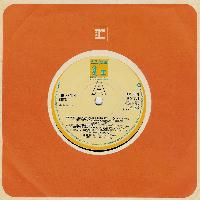 |
UK Brother K54008 yellow Brother label Fine quality pressing, with mint EP |

|
Israel Reprise K54008 brown Reprise label references to the EP deleted from the sleeve flipback sleeve |
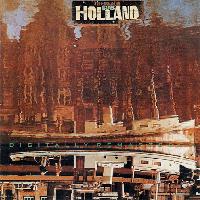 |
CD first release Epic 467 837-2 Caribou/Epic/Brother release Note green lettering on front Not a bad CD at all. |
 |
USA CD second release Capitol 525 694-2 released together with So Tough 24-bit remaster with superb sound This has been used as the basis for a new personal home-made CD-R featuring the tunes in the original line-up. |
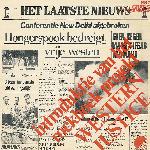 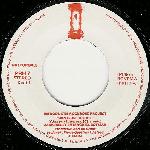
|
Promo for Jack Reiley's album Western
Justice (45) Bovema On this promo 45, Jack Reiley speaks in the Dutch language, explaining how he met collaborator Machiel Botman during the making of the Holland album, going on to produce the Western Justice album and book set.
|
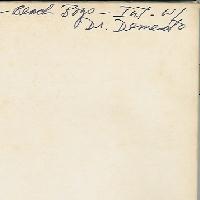 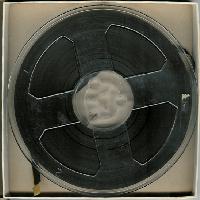
|
The Holland Interview with Dr. Demento Two Reel Tapes, stereo 7-1/2 i.p.s. About 1 hour. Note: A 1973 Radio interview with Dr. Demento. This interview was done to promote the release of the Holland album. Apparently this interview was never broadcast. Present at the interview were Carl Wilson, Dennis Wilson, Al Jardine, Mike Love and Ricky Fataar. Absent were Brian Wilson and Blondie Chaplin. Songs played were Friends (Intro and Exit), California Saga: California, Feel Flows, Surfin', Surfer Girl, Transcendental Meditation, Wind Chimes, Darling, Sail On Sailor and Good Vibrations.
|
The Beach Boys 1973 album "Holland", was recorded as the title suggests, in Holland, also known by its correct name, the Netherlands. Due to the logistic nightmare of housing the Beach Boys and families and transporting their recording equipment to the Netherlands, this album became one of the costliest of all Beach Boys albums to produce. Warner Brothers were keen to turn their investment into a profit and commisioned the promotional booklet shown below.
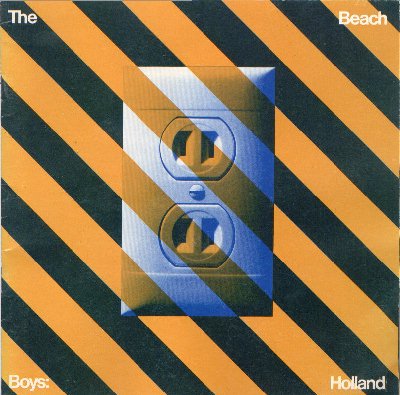
Front of
Booklet
(rear has same pattern, no sockets, no words)
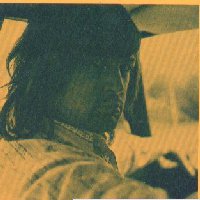 Brain Wilson |
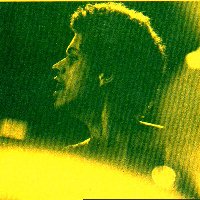 Blondie Chaplin |
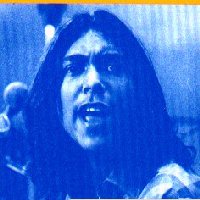 Ricky Fataar |
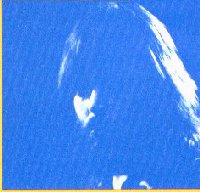 Carl Wilson |
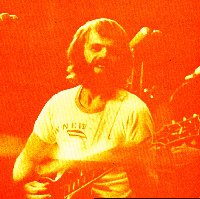 Al Jardine |
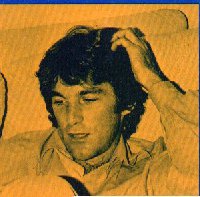 Dennis Wilson |
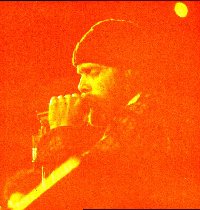 Mike Love |
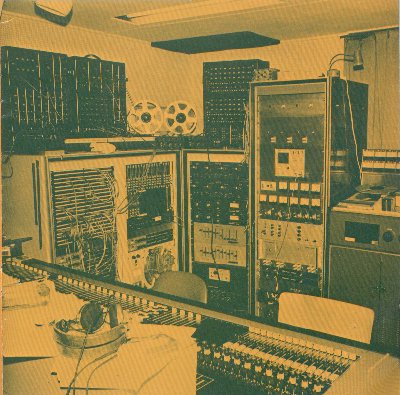
The Studio in Baambrugge, the Netherlands
where "Holland" was recorded
Here is the full text of this booklet.
Until now, in a career spanning more than a decade, the Beach Boys have recorded exclusively in California. They were the patron saints of surf boards, Hondas and cruisin'. With record sales in excess of 70 million (group sales second only to the Beatles), they spread the good-time gospel all over the planet. The Beach Boys/California identity became so powerful that one virtually stood for the other. That proved a mixed blessing. And suddenly last summer they reacted, on no less than a monumental scale, to a pressure that had built up over several years. Concentrating on their widely recognized obsession - technological advance - they took off for Holland where the surf's NEVER up and went through some half a million dollars settling in and arranging for nearly four tons of flying studio, a prototype for the future, to be brought from America. The evidence of the whole incredible adventure is their new album, simply called Holland .
The Beach Boys did not pick Holland for their getaway entirely at random. As they've often sung, they've been all over the great big world. They know precisely what they're looking for. In February of this year they came to Amsterdam to appear on the Grand Gala du Disc, a Dutch TV spectacular. They had not been to Holland since December, 1970, when they battled crippling logistics with sensational results. After being fogged in at London-Heathrow, they scrambled for a jet at neighboring Gatwick Airport. They could not get a flight to Amsterdam, so they landed in Brussels where they were met by a caravan of a dozen Mercedes. They drove like madmen to Amsterdam where a play-by-play account of their progress was being broadcast to the waiting audience. As dawn approached, the band sincerely doubted there would be an audience, if and when they made their destination. But when they strode on stage a quarter past five in the morning, it was to a full and clamoring house. Most rewarding, from the band's viewpoint, was this crowd's enthusiasm for their new music. (They weren't all screaming "Fun, Fun, Fun.") It left the Beach Boys with lasting gouda vibrations. When the group returned for the TV special, it was thought that they'd stay only a week. The week turned into months when they gladly succumbed to the spell of Holland's all-encompassing calm. They decided Amsterdam would be the base camp from which they administer their European tour, that the tour would wind up there and that they'd stay on to do some recording. The latter decision brought with it problems in logistics that made the '70 stunt look pale.
The first person to suffer the extent to which this was not going to be easy was one Bill de Simone, erstwhile Hollywood PR man. His job was to fix houses and transportation for the entourage. (The roll-call below will indicate the toughness of being in Bill's shoes, wooden or Florsheim) With no prior knowledge of Holland's critical and chronic housing shortage, Bill manfully tried to retain the necessary 11 houses in Haarlem, a handsome residential area convenient to EMI studios. In two weeks, he did well to find four. Inevitably, personnel were scattered within a 30-mile radius of central Amsterdam. The scatter-ees were Brian Wilson, his wife, two children, sister-in-law and house keeper; Dennis Wilson with wife and child; Carl Wilson with wife, two children, mother, brother-in-law, housekeeper and two dogs; Mike Love, with wife, two kids and a maid; Al Jardine with the same as Mike; Ricky Fataar with wife and in-laws; Blondie Chaplin and girlfriend. For starters. Then there was chief engineer Steve Moffitt with secretary and son; additional engineers Gordon Rudd and wife, Jon Parker and girl, and Thom Gellert and admirers; Russ Mackie, the group's traveling attach�; Jack Rieley, Brother Records' senior officer and the man at whom the buck stops, his secretary Carole Hayes and her husband, plus Jack's dog. And not least, Bill, who sought shelter for all. In the end they were sprinkled through the Netherlands thus: Jack, Russ and Carole in Amsterdam; Carl and Blondie in Hilversum; Brian in Laren; Ricky in Vreeland; Jon and Thom in Haarlem; Gordon in Heemstede; Steve in Assendelft; Mike and Al in Bloemendaal - all converging on a converted barn in Braambrugge. Before the houses were ready, all were put up in hotels. The musicians' houses were each outfitted with rented stereo and piano. They rented nine Mercedes, one Audi, bought three VW's and van. Aging visibly as he speaks, Jack says, "Some day accounting will face a column just called 'Holland'". Before they obtained their present Amsterdam office, Jack's duplex apartment, a furnished summer rental, became Brother Records' European headquarters. The office was set up in the children's room, already resplendent with bears, dolls and tables not exceeding one and a half feet in height. A Telex was installed with an obliging Dutch answering service. It handled on the average, three-quarters of an hour's messages per day, the printed sheets unfurling like an endless paper towel. So many transatlantic calls were placed that the international operators in Pittsburgh, through whom all such calls are relayed, got wise to the number and noted it to save time.
As if things weren't hair-raising enough, there was the ticklish business of Brian. Brian had not budged in seven years, ever since he gave up touring with the band. His hearing is difficult and painful and he is intensely shy - perhaps the more so for having been dubbed "brilliant" or "genius" by various admirers. Any description of him as a homebody or private person would still fall short of the truth. He once retired to his room, somewhere in the rambling Edgar Rice Burroughs house in Bel Air, for six solid months. To further avoid even local travel, he constructed a substantial studio in the living room of this same house (a 30's Gothic affair, right down to the secret panels). With their passion for technological improvement, the group gradually made this studio obsolete by their own standards, and besides, Brian's wife thought it was about time to do some living in the living room. The studio was duly dismantled. Getting Brian to Amsterdam was every bit as touch-and-go as getting Bobby Fischer to Reykjavik. A miasma of false starts and silences. His wife, kids and housekeeper went over first. Twice Brian got as far as the airport and turned back. The third time he appeared to get on the plane. A phone call went through to Amsterdam to confirm it. But three hours after the plane landed there was still no sign of him. A search of the aircraft yielded Brian's ticket and passport, abandoned on his seat. Oblivious to the panic was Brian who had shuffled off the plane and fallen asleep on a couch in the duty-free lounge, where he eventually was found.
Of course when the initial decision to record in Holland was made, it was assumed that the group would use Dutch facilities. They learned soon enough, however, that the few existing studios were already overtaxed, and no way could enough time for an LP be booked. Still, they had come too far to turn back. They were sick of rush hour, poison air and nerves. So they rashly commissioned a 21st Century board, one borrowing liberally from the future, and set it up in sleepy, rural Netherlands. Steve Moffit was minding his own business somewhere in Santa Monica when he got a call from Amsterdam requesting a studio to be designed and constructed, then disassembled, shipped and reassembled in Holland. Steve, who had worked as engineer on the Carl and the Passions So Tough album, had been involved in discussions of possible recording in Holland one day, but certainly building a portable studio had never been proposed. When Steve assisted with breaking down Brian's living room, a "dream" console - a 24-channel quadraphonic monster - was conceived, but shelved for the time being. Steve's call came in mid-March. He was given a deadline of June 1. His first move was to contact all quality console makers in New York and Los Angeles, requesting prices and specifications for standard models, and emphasizing the deadline. The deadline was a dead end; none of the manufacturers could promise a thing in less than 90 days. Steve's only alternative was to create a studio from scratch. Having made that decision, he decided to go the whole hog and attempt the "dream" machine fantasized during the Bel Air breakdown. He would need help. Friend and physics whiz Gordon Rudd was understandably reluctant, but he was the only man with whom Steve felt the project had a chance. Looking back, Steve says, "It was a ridiculous task to start with, with only two men working on it - even for a stock model. But the manufacturers were proposing ones twice the size with half the functions. Most of the people who design consoles have never actually had to use them".
When Steve and Gordon completed their design, construction took place in a 2,000 square-foot warehouse/laboratory in the back of an "adult" movie house in Santa Monica. The place also served as an inventory of all Brother Records' gear, including the earthly remains of the Bel Air studio. Once construction started, assemblers worked 24 hours a day in shifts to get the job completed. As soon as he'd finished his co-ordinating work with console in America, Steve flew to Amsterdam to supervise its assembly there. When the components for the custom-built studio began shipping, Beach Boy equipment occupied every single flight from LA to Amsterdam (of which there are four daily) and, to correct breakdowns, every Amsterdam to LA flight (of which there are three daily), for four and a half weeks. The specially made crates alone cost over $5,000. The heaviest single item, the racks containing the limiters, Kepexes, Dolbys and prodigious patch bay, actually cracked the tarmac as it was rolled out to the plane for loading. The gross weight of all parts was 7,300 pounds. It was dodgy. Although the individual parts had been tested, the system as a whole had not had time for a try-out, and now the condition of any part may have been affected by the extreme cold in the plane's freight bay. Even if they stayed in California, it often takes a full month to get a new system compatible. They were flying blind. Steve recalls, "We finally got it all hooked up...and NOTHING worked right!" He adds with professional calm, "You learn in electronics to expect anything." He and Gordon, who followed on to nurse the monster, began working 18-hour days trouble-shooting. The aggregate delay of four and a half weeks scotched the groups' plans for extra touring in order to defray the summer's staggering expenses. The group meanwhile wanted to mix down a live tape from their spring European tour. The 3M 16-track was unhitched from the control room and taken to a studio in town, where it proceeded to blow up and all but catch fire. Steve was prepared with over $3,000 worth of spare parts - everything, in fact, except the one that was needed to fix it. A 3M man was flown from London to put it right. It then behaved impeccably until the end of the Holland mission, when it blew up again as Steve was trying to make copy tapes. Throughout the recording period, Steve tended the touchy apparatus exhaustively, vetting it out for four hours before recording began each day, and for another two hours after finishing up. It was a Herculean labor, but Steve stayed cool, meditating at home in suburban Assendelft where TV of a Friday evening affords a choice of Flipper, Zorro and Rod McKuen. And it was entirely worth it when he stood back and admired his creation - the streamlined, multi-colored console supported on two pedestals with no wires visible, glowing futuristically in the dark. It was a wondrous anachronism, sitting there in a one-time farm building in rural Baambrugge. The building had, in fact, previously seen use as a studio, with a 4-track used primarily for commercials and the odd Christmas album. Out front it still bears the imposing name BBC2 (curiously, no relation to BBC2 of Britain). Inside it was a disaster when Steve found it. The acoustics were dreadful. He began by having the floor re-laid six inches higher so that the cables could run under it. Sand was poured between the uprights to avoid resonating. (Even the speakers had sand, Malibu sand at that, to prevent resonance.) Angles were built into the ceiling, which was covered with spun glass. The fiendish fluorescent lighting (strangely popular in Holland) was quickly replaced with a multitude of Study-Buddy lamps, stuck on the wall, covered with different colored gels and controlled by dimmer switches. The building's delighted owner rushed around taking home movies and garnering autographs, in between looking after the cows whose faces loomed directly out the studio windows.
Anyone with enough spare cash to buy a private jet or pay parking fines in New York City can now learn what is required to duplicate the Beach Boys' revolutionary control room at home. Start with a Clover Systems (Gordon's firm) 30-input console with 20-channel monitor system. Add 30 quad pans, 30 stereo pans and a 1,000-hole patch bay with 1,000 jacks to stick in it. (This will be the biggest patch bay on your block.) From England you will need 20 Dolby Noise Reduction Units, which alone will set you back more than $12,000 (and to think, until a few years ago all records were made without them). Still, if you don't want that natural hiss tape makes dirty-ing up your sound, it's gotta be Dolbys. (The Beach Boys' studio is actually wired for 34 Dolbys, which they'll get around to installing when they discover a way to use all those 24 tracks). Speaking of clean sound, for another four and a half grand you can get 16 Kepexes. These are not extinct birds, as their name implies, but rather magical devices which allow sound through to the tape only when the voice or instrument is performing, thus eliminating the normal hum and buzz that plagues idle but turned-on equipment. They were supplied to Steve and Gordon by the clever wags at Alison Research, which is named after the wife of the guy who does the researching. From these same loonies, Steve and Gordon got four limiters, more standard equipment, inexplicably called Gainbrains. What limiters limit is the dynamic range of sound, diminishing too-loud noises while beefing up weak ones, and, in particular, encouraging guitar notes to sustain. All the Kepexes and Gainbrains are adorned with little cameos of Alison herself, at no extra cost. Fleshing out the Beach Boys' control room are one Cooper Time Cube Audio Acoustic Delay Unit, two Little Dipper filters; two SAE Graphic Equalizers (these are tone control devices analogous to the treble and bass control on home hi-fis, only more sophisticated); an Orban Parasound stereo mixer; and to deal effectively with foreign power, three Variable Speed Oscillators to run the tape at 60 cycles; a 3M 16-track tape machine with VSO built in; and a 3M 2-track machine for mastering from the 16. For cue system and studio monitors Steve used Crown D60 amplifiers; for the control room monitor, a pair of custom-built Crown DC300 amplifiers. Two speaker systems were especially made for Holland, incorporating a concept he'd been working on for five years. When mixing down, the group uses inferior speakers - the object being to get the sound first-rate on any home system. Reviewing the particular qualities which he feels set this system apart from other good ones currently in use, Steve first cites its modular construction. Although it is only "half" portable (it takes a week to disassemble), it does allow for individual parts repair and replacement within a minute. Second, at the push of a button, all equalization from the main part of the console is switched into the monitor system. Third, the peak indicating meters indicate with light rather than needles, so they needn't be watched as closely. It is as if your car's speedometer turned from white to red as soon as soon as you went over the limit. Fourth and greatest convenience is the 1,000-hole patch bay which acts as a fail-safe system, especially useful for mix down. Anything can be patched into anything. If an equalizer breaks, you patch it out and patch another one in. You can reassign the position of already-recorded tracks, grouping them as you like. You can put a limiter before or after faders, or anywhere you like. Steve said they had occasion to use it all. As he packs up his things in preparation for another American tour, Carl Wilson reflects on why Holland was such a good idea. "We've all been wanting to leave LA for a couple of years now. Holland is friendly in every sense. The environment eliminates distractions. The only kind of tension is the good kind of working tension - not the kind you get crossing LA in rush hour. There is a subliminal feeling of safety here. We worked long hours to make up for the delay, usually waking in the afternoon and then working 'til 5 in the morning. It was so perfectly still at night. Sometimes we'd walk out and see Venus like a headlamp - amazingly bright!"
There was one incident that temporarily threatened tranquility. A musicians' union called ANOUK (a subdivision of one of the labor federations) was mighty suspicious of the Beach Boys' presence. They thought the band might be taking away work from Dutch musicians, wanted them investigated and, if need be, deported. Brother Records prepared a dossier to explain they weren't doing any Dutch out of jobs, that they were in fact using Dutch sidemen on occasion (p. ex. the strings on "Only with you"), that they hoped their activities would give a boost to Holland's music scene. ANOUK was agreeable. Their only regret - and a fair beef - was that Dutch musicians couldn't hope to do the same thing in America, due to the notorious strictness of U.S. Immigration. Overall, relations with the Dutch throughout the project were extremely good. The group recalls with amusement that fans approaching for autographs were given away by the sound of their wooden shoes on the cement outside the studio.
Approaching Baambrugge from Amsterdam it is as once plain why Carl described as "a really good change, a completely different experience." The drive takes about 20 minutes along a four-lane divided highway flanked on both sides by flat fields, cows and canals. Sea birds fly overhead. The windmills are really there, just like in the pictures, turning with spatulate grace. The highway patrol drive Porsches and it is said that the gypsies drive Mercedes. BBC2 sits among a collection of unprepossessing farm buildings, adjacent to a defunct greenhouse. Just inside the door are stacked 15 empty cases of Coke, conclusive evidence of American occupation. In the studio proper JR is methodically packing the final bits. JR was the one who packed the equipment originally in LA for shipping to the Netherlands; now he has flown over specifically to re-pack the lot. After proudly displaying a handsome trunk he picked up in the Amsterdam flea market to cope with the extras, he rhapsodizes about Great Packing. He cites Dolbys and Thorens turntables as the apex of the art, swathed in unending foam rubber and expanded polystyrene. Everywhere the studio shows signs of recording's universal depredations - the carpet tiles littered with ash, empty cigarette packs, glutinous coffee cups, foul ash trays. JR carefully arranges the hardware in fishing tackle boxes. Assorted percussion gives a tell-tale rattle inside its horseshoe-shaped box. Inside each of the custom-built crates is a neatly typed list of contents - as if everything were going off to some unimaginable summer camp. Of course over the months loads of stuff has accumulated that was not part of the original design - art supplies and empty reels, a crate of fat 16-track tapes and skinny 2-tracks, mike chord, headphones, giant rolls of jute cloth. The floor is deep in the tools of the packer's art - pliers hammer, scissors, screwdriver, string, Magic Markers and the ubiquitous foam rubber. JR leaves his work for a moment and carefully undoes the cover to display the console, like Carter revealing the golden mask of the boy pharaoh - and there it lies, looking positively like God's jukebox. When it arrives safely home it will be reassembled and tested in the warehouse/lab, then dismantled once again for reconstruction at some as yet undetermined site - possibly Topanga or Malibu.
Was it worth it? Or was this all a very complicated dream, anyhow? Well, the Beach Boys stand behind the experiment, more than pleased with the results. Brother Records has become so enamoured of Holland that they have set up a permanent office in Amsterdam, an exquisite 17th Century house overlooking a mossy green canal. Upstairs, resounding among the antique furnishings, is the shiny black round thing that al the fuss was about. Carl is still too close to the business to be objective - that will take months. But the other listeners are smiling that knocked-out smile, and it looks like the right idea was Holland.
- Shelley Benoit
November,
1972
In their six-month emigration to Holland to realize an album project, the Beach Boys have demonstrated both a broadened insight into being and a good grip on the purpose for contradiction. The decision to leave California, where the group had recorded all of its previous studio efforts, bore with it the challenge to rediscover "why" a land of 24 hour a day supermarkets could still hold value for humans anguished over their home's ecological condition long before linguists named it. The contradiction of the Beach Boys is borne in many forms. Most notable of late was the bringing of two South African blacks, Ricky Fataar and Blondie Chaplin, into "all that is American and white." However, in Holland the Beach Boys have imparted reason for that contradiction and served their audience with new ones as well: - they left a land of water, California, for a change, but landed upon the land stolen from water, Holland, where they recorded the cries of drowning men and floating images more imaginatively than any before then have attempted; - they looked at the land they spurned and praised it, returning to that land nostalgically but without hope of tomorrows.
"Sail on Sailor" is a Brian Wilson-Jack Rieley song with writer credits suggesting informal assistance from a wide range of characters, among them Van Dyke Parks. It takes the composers sense of rueful sorcery to a politically radical plateau, accompanied lyrically by one of the more blunt statements of the quality of being ever uttered by the Beach Boys. Blondie Chaplin sings lead, and Carl Wilson produced.
"Steamboat" is the adventure of sound as life's re-creation - of recorded production as blood's pulse. Dennis Wilson-Jack Rieley written, the song is descriptive and chugging, like the vehicle for which it is named. Carl sings lead on this one and co-produced with Dennis. Tony Martin plays steel guitar.
"Big Sur" marks the first time Mike Love has composed the music as well as written the words for a song, and is the first part of the trilogy California Saga which examines the ghettoized cloisters of what remains in dear California. Mike sings lead and Alan Jardine and Carl co-produced.
"The Beaks of Eagles" came originally from a poem by Robinson Jeffers which Alan Jardine found one day. In it a certain tense of natural nobility is portrayed, then praised in brief verse sung like a clear bell by Jardine, who singly wrote.
"California", which the author also refers to as "on my way to sunny Cal-i-forn-eye-ay" - the line sung from the seldom heard vocal chords of Brian Wilson. In the song a certain flashback montage permeates a generally high descriptive lyric. Al Jardine composed the words and music and co-produced with Carl.
"The Trader" is a two-part Carl Wilson painting - his first effort since "Feel Flows" and "Long Promised Road" appeared on the Surfs Up album. In it recorded production reaches new heights in glory and measure: like a many-layered puzzle whose pieces are nothing singly but which, when put together, registers incredibly upon the sensory scoreboard. The Jack Rieley lyric condemns the imperialism of Holland's yesterdays and America's todays, both from the viewpoint of the perpetrator and from that of the victim. Carl sings lead and Carl produced.
"Leaving This Town" stalks ground of deeper inner experience and is built of a beautifully simple structure created by Ricky Fataar. Unlike the composer's two earlier Beach Boys efforts (on the So Tough album), this song takes full advantage of the musical coexistence of diversity which Brian Wilson has for so long expounded. The integral quality of the recording is even more apparent when the credits are shown, revealing back-up writing from Carl Wilson, Blondie Chaplin and Mike Love. Blondie Chaplin sings lead, Ricky produced and also did the Moog solo.
"Only With You" is Dennis Wilson's beauty and wonder expressed in group form; Mike Love wrote the words and brother Carl sings the lead. Dennis' emotionalism is soft and gentle here, as it was on Sunflower's "Forever" and Friends' "Little Bird". It contrasts both in form and effect from his contributions to So Tough .
"Funky Pretty", the last cut on the album, is one of the more descriptive titles ever laid upon a song. Brian Wilson composed this one, of course. It is equally the first and the last word of its title. It incorporates every member of the group equally, and features no fewer than four melodies running concurrently through the verse. The Mike Love-Jack Rieley lyrics are at once humorous, mystical and perverse. Even the lead vocal is shared - by four of the group members. The song's tag incorporates perhaps a dozen moving parts. Brothers Brian and Carl produced.
Those buying Holland are recipient of a so-called gift from Brian Wilson, in the form of a 45 that the Beach Boys like to refer to as his fairy tale. Titled "Mount Vernon and Fairway", it is in reality a post-Sartre essay on the nothingness of being, carrying with it joy and exhaltation which evaporates time as nothing Brian Wilson has ever attempted before. It is not a rock opera, so it will disappoint some and insult perhaps a few listeners. It is the classic form of the fairy tale and nothing else. Nothing else, that is, except perhaps an autobiographical look at Brian Wilson's early planet. He wrote the words, music and text, and also provided the Pied Piper voice.
| No. | UK Test Pressing | German 1st press | Standard LP press | UK 8-Track | USA 8-Track | UK Cassette | USA Cassette 1 | USA Cassette 2 | USA Reel |
| 1 | Steamboat | Steamboat | Sail On Sailor | Sail On Sailor | The Trader | Sail On Sailor | Sail On Sailor | Sail On Sailor | Sail On Sailor |
| 2 | Big Sur | Big Sur | Steamboat | Leaving This Town | Funky Pretty | Leaving This Town | Steamboat | Steamboat | Steamboat |
| 3 | The Beaks Of Eagles | The Beaks Of Eagles | Big Sur | Only WIth You | Steamboat (beg) | Only With You | Big Sur | Big Sur | Big Sur |
| 4 | California | California | The Beaks Of Eagles | The Trader | Steamboat (concl) | Mt Vernon And Fairway | The Beaks Of Eagles | The Beaks Of Eagles | The Beaks Of Eagles |
| 5 | We Got Love | We Got Love | California | Big Sur | Big Sur | Im The Pied Piper | California | California | California |
| 6 | The Trader | The Trader | The Trader | The Beaks Of Eagles | The Beaks Of Eagles | Better Get Back In bed | Only With You | The Trader | The Trader |
| 7 | Leaving This Town | Leaving This Town | Leaving This Town | California | California | Magic Transistor Radio | Funky Pretty | Leaving This Town | Leaving This Town |
| 8 | Only With You | Only With You | Only With You | Steamboat | Sail On Sailor | Im The Pied Piper | The Trader | Only With You | Only With You |
| 9 | Funky Pretty | Funky Pretty | Funky Pretty | Funky Pretty | Leaving This Town | Radio King Dom | Leaving This Town | Funky Pretty | Funky Pretty |
| 10 | Mt Vernon And Fairway | Only With You | The Trader | Mt Vernon And Fairway | Mt Vernon And Fairway | Mt Vernon And Fairway | |||
| 11 | Im The Pied Piper | Mt Vernon And Fairway | Steamboat | Im The Pied Piper | Im The Pied Piper | Im The Pied Piper | |||
| 12 | Better Get Back In bed | Im The Pied Piper | Funky Pretty | Better Get Back In bed | Better Get Back In bed | Better Get Back In bed | |||
| 13 | Magic Transistor Radio | Better Get Back In bed | Big Sur | Magic Transistor Radio | Magic Transistor Radio | Magic Transistor Radio | |||
| 14 | Im The Pied Piper | Magic Transistor Radio | The Beaks Of Eagles | Im The Pied Piper | Im The Pied Piper | Im The Pied Piper | |||
| 15 | Radio King Dom | Im The Pied Piper | California | Radio King Dom | Radio King Dom | Radio King Dom | |||
| 16 | Radio King Dom | ||||||||
| Separate EP | Separate EP | ||||||||
| 1 | Mt Vernon And Fairway | Mt Vernon And Fairway | |||||||
| 2 | Im The Pied Piper | Im The Pied Piper | |||||||
| 3 | Better Get Back In bed | Better Get Back In bed | |||||||
| 4 | Magic Transistor Radio | Magic Transistor Radio | |||||||
| 5 | Im The Pied Piper | Im The Pied Piper | |||||||
| 6 | Radio King Dom | Radio King Dom |